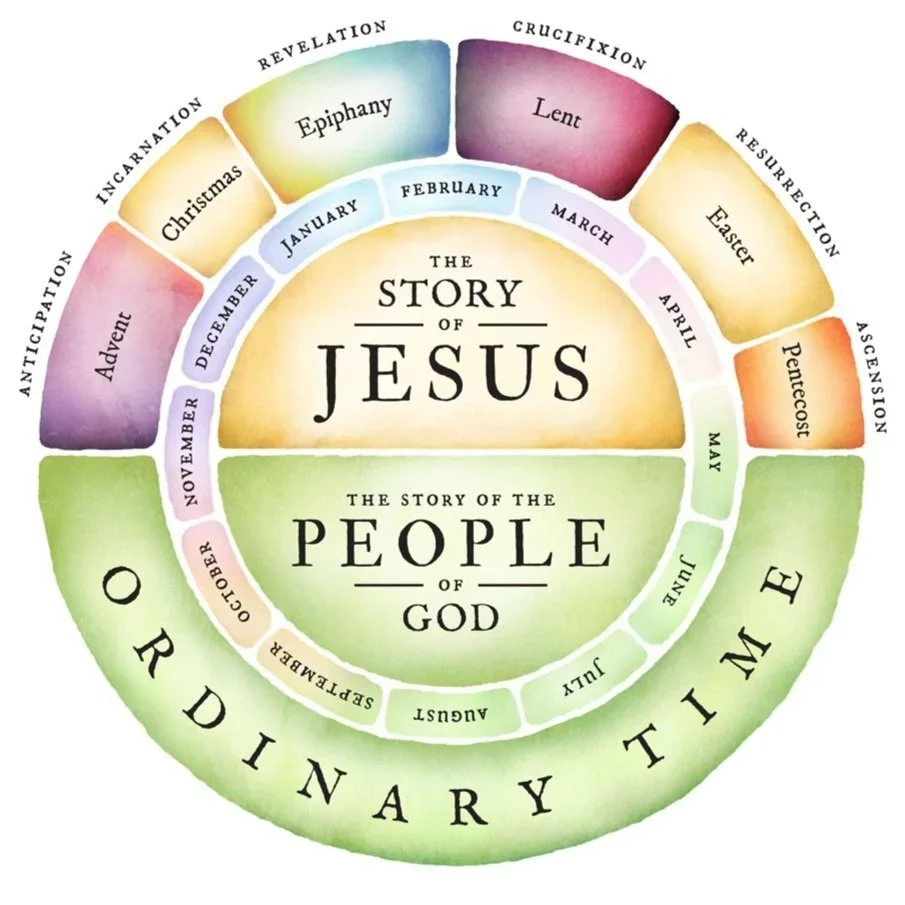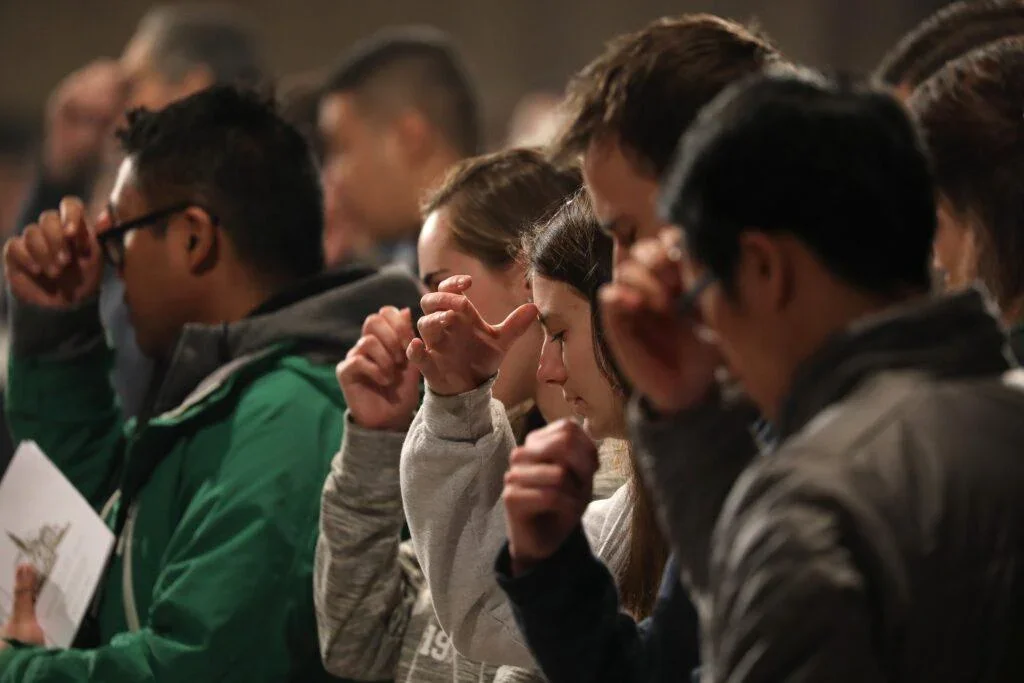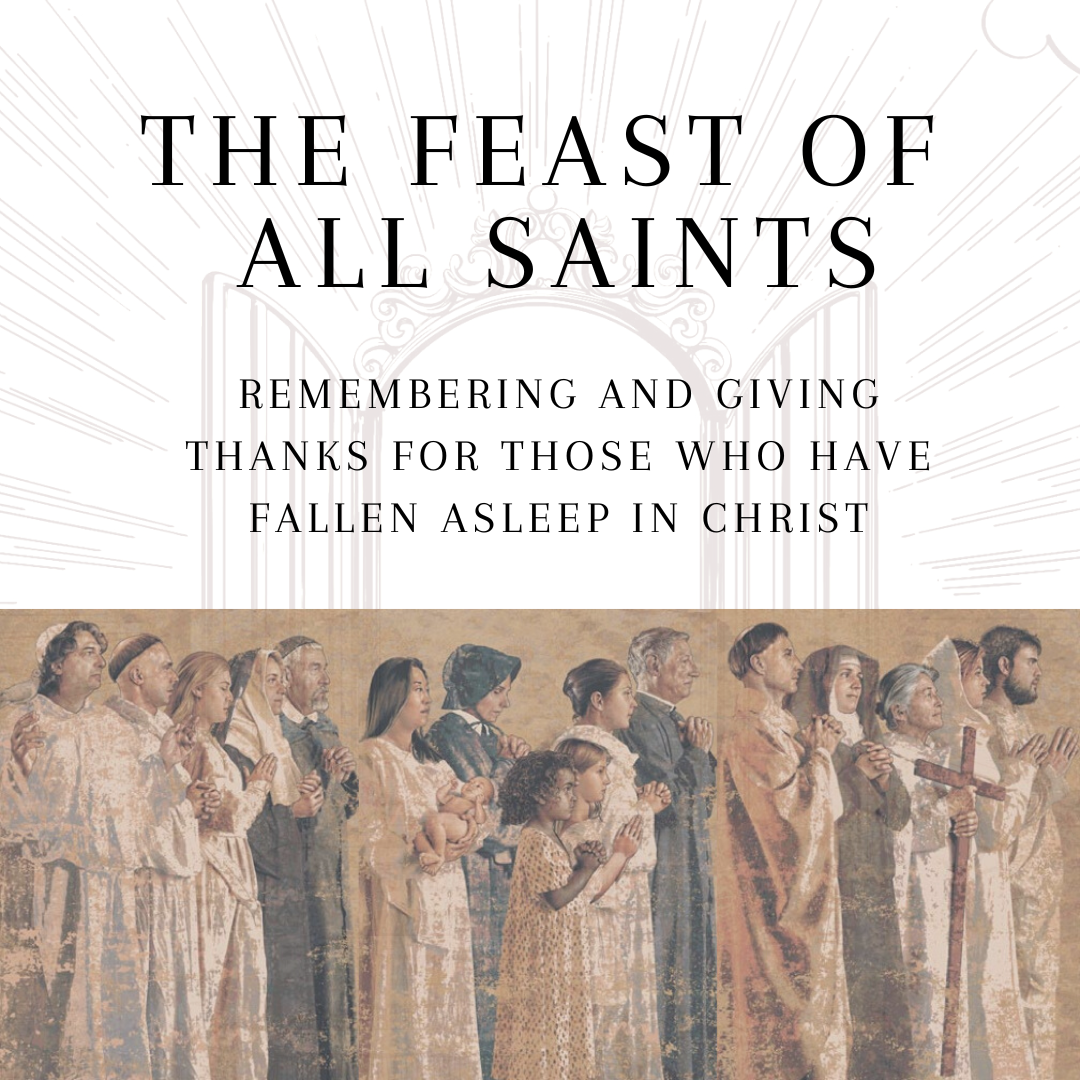Introduction to the Church Year
An Introduction to the Church Year
If you’re new to the Lutheran tradition—or to any church that follows the historic liturgical year—you might wonder why the calendar feels so different from the one hanging on your wall at home.
The Church Year is not just a schedule, it’s a story. And even more—it’s your story in Christ.
Instead of structuring our spiritual lives around deadlines, sports seasons, school calendars, or holidays created by marketing teams, the Church Year invites us to structure our lives around the life of Jesus. Every season helps us remember, celebrate, and enter more deeply into what Christ has done for us and what He is doing in us.
It’s a way of saying, week after week: “My life is hidden with Christ.” (Col. 3:3)
Let’s walk through these seasons together.
Advent — Anticipating the Coming Christ
Advent is the beginning of the Church Year—a season of waiting, longing, and expectation. It stands in quiet contrast to the frenzy of December. Here we slow down and learn to pray: “Come, Lord Jesus.”
We remember His first coming in Bethlehem.
We recognize His coming to us now through His Word and Sacraments.
We anticipate His final coming to make all things new.
Advent trains our hearts in holy longing—teaching us to desire Christ above all.
Christmas — Celebrating God Coming in the Flesh
At Christmas, the waiting gives way to wonder. For twelve days, the Church celebrates what Christians call the Incarnation—God taking on human flesh. Not a myth. Not a metaphor. God actually came among us. Christmas tells us that God is not distant, but near. Not abstract or cold, but embodied and compassionate.
This season invites us to marvel at the humility, tenderness, and glory of Jesus—God with us.
Epiphany — Christ Revealed as Savior of the World
After Christmas comes Epiphany, a season of light. The word epiphany means “revelation,” and this season focuses on moments when Jesus’s identity shines clearly—His baptism, His miracles, His teaching, His call to the nations.
If Christmas tells us who He is, Epiphany shows us what He came to do: bring salvation to the whole world. It’s a season that expands our vision and enlarges our love.
Lent — Preparing for Holy Week
Lent is a season of repentance, reflection, and returning to the Lord. It’s not about earning God’s favor—Christ already won that for us. Lent simply helps us see how much we need Him and invite the Spirit to cleanse our hearts from the sin and distractions that keep us at arms distance. During these forty days, we echo the ancient prayer: “Create in me a clean heart, O God.”
This season trains us in humility, honesty, and hope as we prepare for the central story of our faith.
Holy Week — The Heart of the Christian Story
Holy Week brings us to the center of it all.
Palm Sunday — Jesus enters Jerusalem as King.
Maundy Thursday — He gives us His body and blood in the Supper.
Good Friday — He dies for the sins of the world.
Holy Saturday — He rests in the tomb.
Easter Sunday — He rises in victory.
This is the week that changed the world—and changes us. Holy Week invites us into the depth of Christ’s love, the weight of His sacrifice, and the joy of His resurrection.
Pentecost — The Spirit Sends Us Into the World
Fifty days after Easter, we celebrate Pentecost—the moment when the Holy Spirit descended on the disciples and the Church was filled with power.
Pentecost reminds us that:
The Christian life is Spirit-enabled.
The Church has the glorious tasks of sharing Jesus with the world.
Christ continues His work through us.
What begins at Pentecost continues today in every congregation—including ours—as the Spirit forms Christ in us and sends us out as His witnesses.
Why the Church Year Matters
For many who are new to this tradition, the Church Year becomes one of the most meaningful discoveries of their Christian life. It gives:
Beauty
Each season paints a different facet of the gospel—light, joy, repentance, hope, victory.
Stability
In a chaotic world, you’re rooted in something older, deeper, and steadier than culture’s constant changes.
Formation
The Church Year shapes your heart over time, teaching you to live your days in step with Christ.
Joy
You don’t just learn about Jesus—you journey with Him.
Walking through the Church Year is like walking through the gospel again and again until it becomes part of you.
Your Invitation to Enter the Church Year
The Church Year isn’t just an idea or a history lesson—it’s a lived journey of formation, worship, and joy. It’s a way of letting the life of Christ shape the rhythm of your life… week by week, season by season, promise by promise.
And you’re invited to step into it with us.
At Trinity San Antonio, we walk this sacred path together—waiting in Advent, rejoicing at Christmas, beholding Christ in Epiphany, slowing down in Lent, standing in awe during Holy Week, and living in the Spirit’s power throughout Pentecost. Every Sunday is a doorway deeper into the story of Jesus and into the life God is forming in us.
If you’re longing for a church family, curious about historic Christian worship, or simply ready for something deeper and more rooted—come join us.
Visit us this Sunday at 10:30am and begin the journey. We’d love to walk it with you.
~ Pastor Matthew Ballmann
The Sign of the Cross: A Mark of Our Baptismal Identity
“Let us not be ashamed to confess the Crucified. Let the cross be our seal, made with boldness by our fingers on our brow and on everything.” – St. Cyril of Jerusalem, Catechetical Lecture 13
The sign of the cross is not superstition, nor a meaningless gesture. It is a holy confession: a physical sign, a joyful celebration, and a faithful response to the spiritual reality of having been adopted into God’s family through Holy Baptism.
The Cross as a Sign
When we trace the cross upon ourselves, we are marking ourselves in the Name of the Father, and of the Son, and of the Holy Spirit. This action echoes back to our one baptism into the Triune God (Matt. 28:19). It proclaims that we have been given His Name, adopted into His family, forgiven of our sins, and made heirs of an everlasting inheritance.
St. Basil the Great explained: “This is taught by unwritten tradition: that those who hope in the name of our Lord Jesus Christ sign themselves with the sign of the cross.” (On the Holy Spirit, 27.66)
Each time we make this sign, we are reminding ourselves: “I am baptized. I belong to Jesus.”
The Cross as a Celebration
Athletes rejoice when they score, and their fist pumps are visible signs of victory. In much the same way, the sign of the cross is the Christian’s victory cheer — a bodily proclamation that Christ has conquered sin, death, and the devil.
As Tertullian observed in the 3rd century: “At every forward step and movement, at every going in and out, when we put on our clothes and shoes… in all the ordinary actions of daily life, we trace upon the forehead the sign.” (De Corona, 3)
This is not dour ritual but joy embodied: the cross traced on us is a celebration of the resurrection.
The Cross as a Response
In human culture we salute those whom we respect, honor, and love. The sign of the cross is the Christian’s salute to the Lord and King. It acknowledges that Christ has purchased us with His precious blood (1 Cor. 6:20), and it declares to ourselves and to the world: “I am one of His faithful soldiers.”
St. Ephrem the Syrian called the cross “the armor of Christians and the terror of demons.” With it we both honor our Lord and strengthen our own faith in His victory.
Five Times in the Divine Service to Cross Yourself
Though there is never a wrong time to make the sign of the cross, the Church invites us to use this holy gesture especially at these moments in the Divine Service:
Entrance into the Church – As we pass the font, we remember John 3, that we were born anew in Holy Baptism. Many dip their fingers into the font and make the sign of the cross as a reminder: Christ has rescued me and placed His Name upon me.
Invocation – At the words: “In the name of the Father, and of the Son, and of the Holy Spirit.” We confess that we enter God’s presence as His baptized children.
Gospel Reading – A small cross upon forehead, lips, and heart: asking God’s Word to dwell in our mind, on our lips, and in our heart.
After Receiving the Holy Communion – As an act of thanksgiving, many trace the cross following the reception of Christ’s Body and Blood.
At the Creed – At the words: “the resurrection of the dead and the life of the world to come.” We confess the hope that baptism into Christ’s death and resurrection has given us.
The Cross in Daily Life
Beyond the liturgy, Christians are encouraged to make the sign of the cross at any moment: upon waking and at bedtime, before meals, when beginning prayer, in moments of temptation or fear, and when discouraged.
Martin Luther himself encouraged Christians in the Small Catechism to begin and end the day with the sign of the cross, commending ourselves to God’s care.
The cross upon our bodies anchors us in the storm, strengthens us for the battle, and proclaims Christ crucified and risen as our only hope.
“The cross is the guardian of the whole world, the cross is the beauty of the Church, the cross is what strengthens the faithful.” – St. John Chrysostom
So let us make this sign boldly, joyfully, reverently. For in it we confess the mystery of our salvation: Christ crucified, Christ risen, Christ reigning — and His mark upon us forever.
How to make the sign of the cross?
Touch the forehead as you say or pray, “In the name of the Father”
Touch the breastbone as you say, “and of the Son”
Touch the right shoulder, then the left shoulder (or vice versa), as you say, “and of the Holy Spirit.”
Pr. Matthew+
Jesus Weeps Over Jerusalem
“Flevit super illam” by Enrique Simonet (1866–1927) on Luke 13:31-35
Jesus weeps
Jesus comes near and he beholds the city
And looks on us with tears in his eyes,
And wells of mercy, streams of love and pity
Flow from the fountain whence all things arise.
He loved us into life and longs to gather
And meet with his beloved face to face
How often has he called, a careful mother,
And wept for our refusals of his grace,
Wept for a world that, weary with its weeping,
Benumbed and stumbling, turns the other way,
Fatigued compassion is already sleeping
Whilst her worst nightmares stalk the light of day.
But we might waken yet, and face those fears,
If we could see ourselves through Jesus’ tears.
Malcolm Guite’s website.
The Feast of All Saints
Today is the Feast of All Saints, a beautiful feast day where we lovingly remember martyrs and saints who faithfully served the Lord and are now in His glorious presence.
What is All Saints' Day?
Originally All Saints' Day was a day set aside to remember the martyrs of the early church, who had given their lives for their faith in Christ. Today we remember not only these martyrs, but all the faithful who have died in Christ, encompassing the faithful in the Bible, the early church, the more recent past, and even friends or family members who are now in heaven. What Memorial Day is to America, All Saints’ Day is to the Church, a day of remembrance and thankfulness.
Every Sunday we confess that we believe in “the communion of saints” which is to say a spiritual union of all of the members of the Church. This communion includes the living, the Church Militant, and those who have died in the faith of Christ—the Church Triumphant. We are knit together with the saints in the mystical body of Christ. Saint Paul says in his letter to the congregations in Corinthian, “The cup of blessing that we bless, is it not a participation in the blood of Christ? The bread that we break, is it not a participation in the body of Christ? Because there is one bread, we who are many are one body, for we all partake of the one bread.” (1 Cor. 10:16-17).
What is a Saint?
All who are in Christ are saints (1 Cor. 1:2). The word “saint" is derived from a Greek verb (hagiazo) whose basic meaning is “to set apart, " “sanctify,” or “make holy." This title doesn't just belong to a select few Christians but to each and every person who has been forgiven and made holy in Christ Jesus.
Why celebrate All Saints' Day?
All Saints' Day is a great opportunity to reflect on God's faithfulness, to thank Him for the example of faithful believers, and to be inspired by this example. This could be a great time to share with your kids about a faithful grandparent or mentor who God used to draw you closer to Him. You might want to read the story of a faithful saint from the Bible, or a biography of a missionary or early church figure. As we retell the story of the faithful Christians who have gone before, we give our children (and ourselves) a vision for what God could do through us, and our hearts are drawn in faith and praise to Him for His work throughout the ages in ordinary individuals just like us.
How can we celebrate All Saints' Day?
Here are a few ideas to choose from for celebrating this day with your family:
1) Attend a service at a church that celebrates the Feast of All Saints. At Trinity this Sunday we will celebrate this joyous occasion.
2) Read and discuss a passage of Scripture that talks about the saints throughout time, such as: Revelation 7:2-17; 1 John 3:1-3; Matthew 5:1-12.
3) Read a biography about a famous Christian from history. Here are a few of our favorites:
Trial and Triumph: Stories from Church History by Richard Hannula
Patrick: Patron Saint of Ireland by Tomie DePaola
Martin Luther: A Man Who Changed the World by Paul Maier
The Simonetta Carr biographies
Missionary biographies
4) Share about the life of a faithful Christian you knew personally who is now in heaven, and take a moment to thank God as a family for this saint.
5) Host a party where the kids dress up like their favorite saint and tell their stories.
6) Visit the resting place of a love one who died in Christ and give thanks to God for their life. This is a good time to teach your children about the hope of the resurrection!
7) Pray with your family the Collect for All Saints (we will also pray this on Sunday)
Almighty and everlasting God, You knit together Your faithful people of all times and places into one holy communion, the mystical body of Your Son, Jesus Christ. Grant us so to follow Your blessed saints in all virtuous and godly living that, together with them, we may come to the unspeakable joys You have prepared for those who love You; through Jesus Christ, our Lord, who lives and reigns with You and the Holy Spirit, one God, now and forever. Amen.
Let's take some time this November 1st to thank God for the faithful that make up the body of Christ; in heaven and on earth, famous or little known, and to be encouraged to trust in His faithfulness to help us and our children run the race He has for us!
A few hymns for this day:
Albrecht Durer and the Reformation of the Church
The follow article written by Pr. Matthew Ballmann was first published in the Lutheran Ambassador in 2015. I am republishing on this 506th anniversary of the Reformation.
As we celebrate the 498th anniversary of the Protestant Reformation and remember the individuals used by God to bring it about, we also do well to remember the individuals who were impacted by and served as key supporters of it. The German Renaissance artist Albrecht Dürer was such a man. While some in the American church may know Dürer or his art, chances are he is nothing more than a strange name you just read for the first time. Allow me the privilege to introduce you to this incredibly gifted man who was a key recipient and supporter of the Reformation.
Albrecht Durer, The Man
Albrecht Dürer was born in 1471 to Albrecht and Barbara Dürer. He was the eldest son and third of eighteen children, fifteen of which would die at a young age. His father was a Hungarian immigrant who moved to the city of Nuremberg, Germany where he worked as a goldsmith. When Durer the Younger was only thirteen, he became an apprentice to his father in Nuremberg to learn how to be a goldsmith. After only two years of apprenticing, and to the displeasure but support of his father, Albrecht left to do what he really wanted to do - paint.
After leaving his father’s tutelage he went on to apprentice for three years under the painter and printmaker Michael Wolgemut (1434-1519) also in Nuremberg. Wolgemut was the first German painter to design woodcuts as illustrations for the newly developed printed book. It was under Wolgemut that Durer learned the art of woodcut, a skill that would play a crucial role in his career and influence upon the world. After three years under Wolgemut, he went on for an additional two years as a journeyman in which he traveled to Basel, Switzerland. Upon his return to Nuremberg in 1494, Dürer married Agnes Frey in an arranged marriage. They would have no children together.
What was Durer’s relationship to the Protestant Reformation?
While we have no record of him formally renouncing Roman Catholicism, his Protestant sympathies are evident in much of his art and letters. He evidently had suffered some level of judgment for these sympathies when he wrote the following in 1524, “because of our Christian faith we have to stand in scorn and danger, for we are reviled and called heretics.” It was especially the teaching that began the Protestant Reformation, that is the forgiveness of sins by grace, through faith, in Christ, that so powerfully influenced Durer and his work. Interestingly, it was the preaching of Johan von Staupitz, Luther’s mentor and Vicar General of the German Congregation of Augustinians, that first moved Durer to embrace the rediscovered evangelical theology.
It was not just Staupitz that influenced Durer, but Luther too had a significance influence on his thinking. When Friedrich the Wise sent Dürer one of Luther's books in 1520, Dürer wrote the following to the Elector's secretary, “I pray Your Honor to convey my humble gratitude to His Electoral grace, and beg him humbly that he will protect the praiseworthy Dr. Martin Luther for the sake of Christian truth. It matters more than all the riches and power of this world, for with time everything passes away; only the truth is eternal.” It was Luther who helped Dürer find release from his spiritual distress through the preaching of the forgiveness of sins through Christ’s death and resurrection.
Dürer spent the majority of his life living in Nuremburg creating and selling art. Whether it woodcuts, engravings, paintings, or drawings, his work captured the attention and imagination of his contemporary artist and culture at large. When Luther heard of his death 1528, he wrote, “It is natural and right to weep for so excellent a man.” Today Dürer remains among the most admired artists in the history of German art.
Famous Works
As many of the great artist of his day, Dürer had a wide spectrum of skills. He created alter pieces for churches, portraits of both religious and political leaders, and engravings and woodcuts for printed material. To get an idea of the volume he created, today we have about a hundred of his paintings, some one hundred engravings, and roughly two hundred woodcuts. In addition, we have over 1,200 drawings, sketches, and watercolors. From these he was most known and renowned for graphic works. These were created from woodcuts or engravings. Artists across Europe admired and copied Durer’s innovative and powerful prints, ranging from religious and mythological scenes, to maps and exotics animals. The vast majority of his works have biblical images as their objects.
Dürer's earliest major work, The Apocalypse, was a series of large prints illustrating the book of Revelation, with the Scripture on the reverse side. Dürer's large illustrations were detailed and full of energy. His Four Horsemen of the Apocalypse has never been surpassed.
He followed The Apocalypse with a series of seventeen cuts entitled The Life of the Virgin and a large and small series on the Passion of Christ. These illustrations were designed to be used especially by teachers and clergy, but in a day before widespread literacy, could also be important devotional tools for Christian laymen. The Passion of Christ woodcuts are especially powerful in their communication of the suffering of our Savior.
Other famous works include Knight, Death, and Devil in which he portrays a knight in battle armor, pike in hand, riding down a dangerous road located in a valley. On either side of the knight there are two hideous looking creatures. One is holding an hourglass in his hand representing the inevitability of death (common in many of Durer’s works) and the other creature, resembling a goat, is holding a pike in its hand as if looking for a chance to knock the knight off his horse. The valley of course represents the valley of the shadow of death and the trials of life. Off in the distance there is a large and magnificent castle, the destination of every Christian, heaven.
Another of his most well known works is St. Jerome in His Study. Portraying an elderly Jerome sitting in a room with streams of sun rays coming through the windows. Besides the seated saint are books, timepieces, writings, and many other object, all of which carry some symbolic meaning. One such symbol in the room is a human skull, which was meant to serve as a reminder to Jerome of the inevitability of death (memento mori). If you follow Jerome’s line of eye site to the skull there stands a cross of the crucified Savior, reminding him that death has been defeated through Christ Jesus.
Durer’s final great work, a painting, The Four Holy Men - Sts. John, Peter, Mark and Paul, was presented to the Nuremberg City Council as a gift. Below the painting Dürer attached a short message which spoke to the danger of the Roman Catholic Church’s teaching and at the same time affirmed the Protestant commitment to the authority of Scripture, “All worldly rulers in these dangerous times should give good heed that they receive not human misguidance for the Word of God, for God will have nothing added to His Word nor taken away from it. Hear therefore these four excellent men, Peter, John, Paul, and Mark and their warning."
While there is an extraordinary number other powerful pieces we could consider, suffice it to say that Albrecht Durer was a man who was an extremely gifted artist, believed in the good news of forgiveness of sins through Christ by grace through faith, and used his gifts for the proclamation of God’s Word and the glory of God.
For more on Durer’s life and work. And here.














